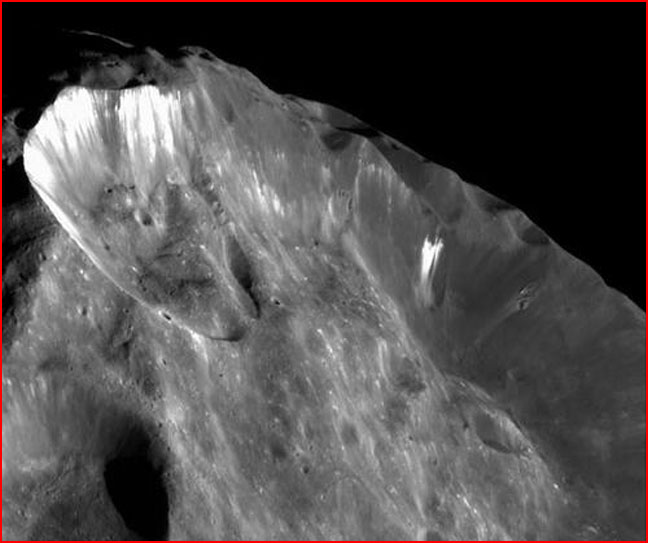
home •
about •
essential guide •
picture of the day •
thunderblogs •
news •
multimedia •
predictions •
products •
get involved •
contact
picture of the day archive subject index
The deeply cratered surface of Saturn's moon Phoebe. Credit: NASA/JPL
Jul 25, 2007
Explaining Phoebe's Giant SpiralWhat could have created the giant logarithmic spiral carved into Saturn's small but enigmatic moon?
Saturn's outer moon, Phoebe is very small, only 220 kilometers in diameter. Its gravity is a mere .05m/s2, compared to the 9m/s2 we experience here on Earth. While the majority of Saturn's other moons are quite reflective of visible light, Phoebe is as black as coal, making it one of the darkest objects in the solar system.
Based on data collected by Cassini, NASA scientists describe Phoebe as "very strange" and probably a captured moon, rather than having formed along with its parent planet. Said Torrence Johnson, a Cassini team member at JPL: "And what it's told us is that it's a collection of ice and rock and probably carbonaceous compounds. We believe this object has many characteristics in common with things like Pluto and (Neptune's moon) Triton in the outer solar system. In other words, it's a first look at one of these denizens of the outer solar system that we've (seen previously) only from afar."
A number of huge craters mark Phoebe's surface, making it look very much like the heavily cratered surfaces of some asteroids. Just as one must ask why the asteroids were not destroyed by the impacts, one must ask why Phoebe was not blown apart by whatever "impact" events excavated these craters. Phoebe's dark surface is also reminiscent of comet Wild 2's surface, revealed when the Stardust probe made its close approach on January 2, 2004. The dark, cratered terrain on both bodies gives them the appearance of twins, contrary to the expectations of NASA observers that Wild 2 would have a "snowball" composition.
Images from the Cassini spacecraft depict a moon that has features like those found on others we have mentioned in recent articles. Some look very much like the craters on Mars, with similar morphology. The crater rims have alternating striations, with steep gullies running down one side and hard edges that appear as if they were cut into the rock and ice. What appear to be rounded boulders lie inside some of the craters as well as in the faces of the crater walls.
A closer examination casts doubt on the notion that the largest crater could have been created by an object smashing into Phoebe. The alternative--formation by plasma discharge--is well supported. The most obvious evidence is the spiral-shaped crater rim and the steeply carved cliffs. These are not features expected under the impact hypothesis. The visual evidence is consistent with a huge electric arc cutting a long chain of craters into one hemisphere, ending in the winding curve and the narrow canyon walls. Of course, the shallow craters, the overlapping rims and the lack of impact debris are also important considerations in the theory of electrical effects, not only on Phoebe but the rest of Saturn's moons as well.
As electrical theorist Wal Thornhill recently wrote:
"The electric universe model explains the craters as Phoebe's birthmarks. It is a model supported by examination of spark-machined surfaces. Just as stars are observed to do, gas giant planets may also expel a jet of matter during periods of electrical instability. Accretion of matter in the jet is mediated by the electromagnetic pinch effect and electrostatic deposition. Both of these mechanisms are far superior to accretion by impacts (tending to shatter and scatter instead of to accrete). Electrostatic deposition easily creates the layering seen in all rocky objects to date. Electrical discharges between the parent and departing child carve out the circular craters. Because they are not formed by a sudden mechanical impact, the craters are neat and do not cause disruption to adjacent craters or fill them with debris as we see on Phoebe."
By thinking only in terms of meteor impacts, landslides and other familiar geological forces, NASA is ignoring the one possibility that makes all the disparate features we see cohesive: an electrically dynamic solar system in its formative phases, when cosmic thunderbolts carved the surfaces of planets and moons.
By Stephen Smith
___________________________________________________________________________Please visit our Forum
The Electric Sky and The Electric Universe available now!

|
|

|
EXECUTIVE EDITORS:
David Talbott, Wallace Thornhill
MANAGING EDITORS:
Steve Smith, Mel Acheson
CONTRIBUTING EDITORS: Michael Armstrong, Dwardu Cardona,
Ev Cochrane,
C.J. Ransom, Don Scott, Rens van der Sluijs, Ian Tresman
WEBMASTER: Brian Talbott
Copyright 2007: thunderbolts.info
![]()
home •
thunderblogs •
forum •
picture of the day •
resources •
team •
updates •
contact us

